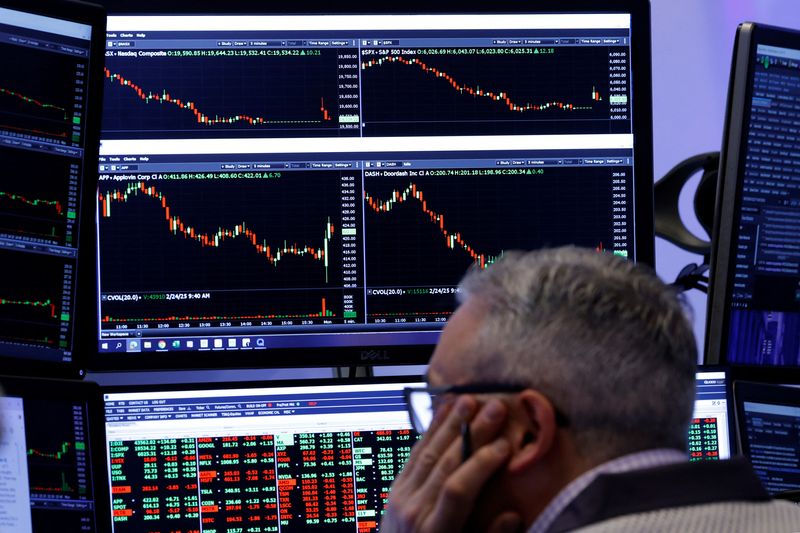
A look at the day ahead in U.S. and global markets from Mike Dolan
Rancorous geopolitics continues to grab most headlines again this week, but it’s creeping anxiety about a slowing U.S. economy that’s unnerving investors most about Wall Street stocks.
Wary of Wednesday’s results from megacap chip giant Nvidia, the S&P500 lost its 6,000 handle for the first time in three weeks on Monday and both the tech-heavy Nasdaq and small cap Russell 2000 are now negative for the year to date.
Even the meagre 1% gain in the S&P500 for 2025 so far is a third of MSCI all-country and far below the 13% gain in Germany’s blue-chip DAX, which was emboldened this week after the election results there and hopes for some fiscal easing.
The VIX ‘fear index’ of S&P500 implied volatility also jumped above 20 for the first time since February 3 and was eyeing up its highest close of the year ahead of today’s bell.
Adding to the tech angst ahead of Nvidia’s update, Chinese mainland and Hong Kong stock indexes both lost more than 1% earlier on Tuesday after a Bloomberg report said President Donald Trump plan to toughen chip restrictions on China – expanding predecessor Joe Biden’s efforts to hamper Beijing’s tech development.
‘ON SCHEDULE’
Keeping trade threats on the front burner, Trump also said overnight that tariffs on Canadian and Mexican imports are “on time and on schedule” despite both countries’ moves on border security and fentanyl trafficking ahead of a March 4 deadline.
And yet market jitters about pricy U.S. stocks were sourced even closer to home, with US stock futures remaining in the red overnight.
Alongside the tech anxiety, the economic numbers this week continue to challenge the ‘no landing’ consensus that has recently built up around direction of overall activity.
With a withering array of new policy initiatives involving import duties, migrant curbs, federal worker cuts and broken international alliances, there’s concern that the uncertainty of the impact is weighing on business and consumer planning.
Retail sales have disappointed into the new year and business surveys are starting to splutter, with one last week showing the dominant U.S. service sector contracting for the first time in two years this month.
The drip-drip of slowing activity was reinforced on Monday by Dallas and Chicago Federal Reserve surveys, too.
The University of Michigan’s household survey on Friday, meantime, shows consumer confidence at 15-month lows in February and the Conference Board’s equivalent consumer sentiment readout today will likely be pivotal during Tuesday’s trading session.

